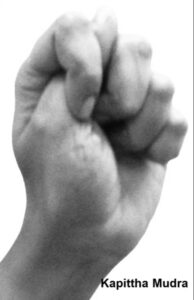Kapittha Mudra
Introduction
Kapittha Mudra is one of the Hasta Mudras (hand gestures) used in classical dance (Bharatanatyam, Kuchipudi, Odissi) as well as in yoga and meditation. In Natya Shastra, it is categorized as a single-hand gesture (Asamyukta Hasta). In the yogic context, it is symbolic and therapeutic, channeling energy to enhance focus, devotion, and grounding. It has both expressive (Abhinaya) and energetic (yogic) applications.
Meaning
Kapittha means “wood apple” or “bilva fruit” in Sanskrit.
The mudra resembles the shape of a fruit held between the fingers.
In dance, it is used to depict Lakshmi, Saraswati, holding cymbals, milking cows, grasping, or offering.
In yoga, it symbolizes dedication, inner strength, and the channeling of feminine divine energy.
How to Perform (Method of Practice)
Step-by-Step:
Sit comfortably in Sukhasana, Padmasana, or Vajrasana.
Insert the thumb in the web between the index and middle fingers.
Close all the remaining fingers as if making a fist.
Place the left hand against the heart, and the right hand against the pubic bone. Soften the chest, throat, and belly, and breathe naturally.
Focus on the feeling of unity between the sexual and spiritual aspects of your life.
Maintain a steady breath and awareness while holding the gesture.
Close your eyes and focus inward (if practicing meditative Kapittha Mudra).
Benefits
Physical Benefits
Improves strength and coordination of hand muscles (used in dance and therapy).
Stimulates the respiratory and reproductive systems.
Helps in reducing lethargy and increasing alertness.
Mental & Emotional Benefits
Enhances devotion (Bhakti) and concentration.
Balances emotions and increases confidence.
Reduces stress by channeling energy toward creativity and expression.
Spiritual Benefits
Associated with Lakshmi (prosperity) and Saraswati (wisdom).
Enhances meditative focus on Divine Feminine energy.
Balances Anahata (Heart Chakra) and Ajna (Third Eye Chakra) depending on intent.
Contraindications
Avoid if you have severe finger joint pain or arthritis.
Should not be forced if there is nerve compression in the wrist or hand.
Avoid long, rigid practice if experiencing carpal tunnel syndrome—instead, do in short intervals.
Anatomy & Physiology
The index finger (air element) pressed by thumb (fire element) symbolizes control of thoughts and ego by higher willpower.
This reduces excess Vata (air element) and channels prana inward.
Physiologically, it stimulates lung function, hand muscles, and blood circulation.
Kinesiology
Flexion of the index finger at the metacarpophalangeal joint.
Stabilization by thumb adduction.
Middle, ring, and little fingers are extended—requiring extrinsic finger extensor muscles to remain active.
Encourages fine motor precision and grip control.
Neurology
Stimulates median nerve (thumb, index finger).
Activates somatosensory cortex related to hand representation.
Encourages parasympathetic activation, leading to calm focus.
Enhances neural circuits of memory, creativity, and devotion when used with mantra/meditation.
Duration of Practice
Dance practice: as per choreography.
Yoga/meditation practice: 15–30 minutes daily, in one or two sessions.
Can be integrated with bhakti yoga, mantra chanting, or pranayama.
Counter Mudra
Chin Mudra – balances energy outward when too much inward focus occurs.
Anjali Mudra – restores emotional balance and grounding.
Hridaya Mudra – balances excess emotional energy if Kapittha becomes intense.
Conclusion
Kapittha Mudra is a versatile hasta mudra that blends artistic, spiritual, and therapeutic dimensions. In classical dance, it depicts divinity, offering, and cultural symbolism. In yoga, it cultivates inner strength, devotion, and clarity of mind. It harmonizes the air and fire elements, strengthens the hands, improves focus, and connects practitioners to higher consciousness and feminine divinity.
FAQ
Q1: Is Kapittha Mudra only for dancers?
No, it has spiritual and meditative uses in yoga as well.
Q2: Which deities are represented by Kapittha Mudra?
Goddess Lakshmi and Saraswati, as well as devotional offering.
Q3: Can it help with stress?
Yes, it calms the nervous system and improves focus.
Q4: How is it different from Chin Mudra?
Chin Mudra symbolizes universal consciousness; Kapittha focuses on devotion and divine offering.
Q5: Can beginners practice it?
Yes, both beginners and advanced practitioners can benefit.
References
Natya Shastra – Bharata.
Abhinaya Darpana – Nandikeshvara.
Swami Satyananda Saraswati – Asana, Pranayama, Mudra, Bandha.
Gertrud Hirschi – Mudras: Yoga in Your Hands.
Vasant Lad – Ayurveda: Science of Self-Healing.

